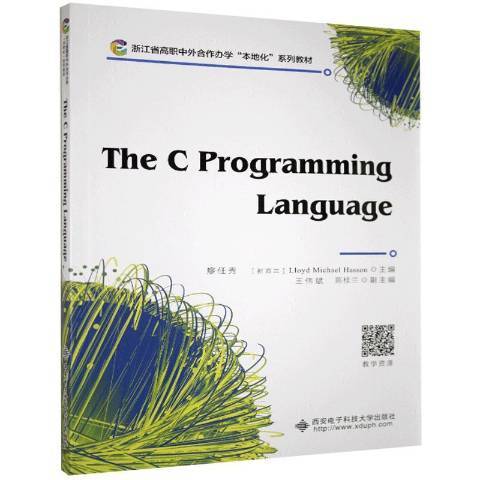《The C programming language》是2020年西安電子科技大學出版社出版的圖書,作者是廖任秀、[紐西蘭] Lloyd Michael Hasson、王偉斌、陳桂蘭。
基本介紹
- 中文名:The C programming language
- 作者:編者:廖任秀//(紐西蘭)勞埃德·麥可·哈森|責編:盧楊//雷鴻俊
- 出版社:西安電子科技大學出版社
- 出版時間:2020年11月1日
- 頁數:224 頁
- 開本:16 開
- 裝幀:平裝
- ISBN:9787560658773

《The C programming language》是2020年西安電子科技大學出版社出版的圖書,作者是廖任秀、[紐西蘭] Lloyd Michael Hasson、王偉斌、陳桂蘭。
一九七八年由美國電話電報公司(AT&T)貝爾實驗室正式發表了C語言。同時由B.W.Kernighan和D.M.Ritchit合著了著名的“THE C PROGRAMMING LANGUAGE”一書。通常簡稱為《K&R》,也有人稱之為《K&R》標準。但是,在《K&R》中並沒有定義一個完整的標準C語言,後來由美國國家標準學會在此基礎上制定了一個C 語言標準,...
《C程式設計語言》是由C語言的設計者Dennis M. Ritchie和著名計算機科學家Brian W. Kernighan編寫的一部介紹標準C語言及其程式設計方法的權威性經典著作。全面、系統地講述了C語言的各個特性及程式設計的基本方法,包括基本概念、類型和表達式、控制流、函式與程式結構、指針與數組、結構、輸入與輸出、UNIX系統接口、標準...
1978年Brian W.Kernighian和Dennis M.Ritchie出版了名著《The C Programming Language》,從而使C語言成為目前世界上流行最廣泛的高級程式設計語言。1987年,隨著微型計算機的日益普及,出現了許多C語言版本。由於沒有統一的標準,使得這些C語言之間出現了一些不一致的地方。為了改變這種情況,美國國家標準研究所(ANSI)為C...
《The C Programming Language, 2nd Eition》是Prentice Hall出版的圖書,作者是Dennis M. Ritchie,Brian W. Kernighan 內容簡介 Brian W. Kernighan: 貝爾實驗室計算科學研究中心高級研究人員,著名的計算機科學家。他參加了UNIX系統、C語言、AWK語言和許多其他系統的開發,同時出版了許多在計算機領域具有影響的著作,...
《C程式設計語言(第2版·新版)習題解答》是一本機械工業出版社在2004年出版的圖書,作者是 [美]湯朵,[美]吉米拜爾 。內容簡介 本書對Brain W. Kernighan和Dennis M. Ritchie所著的《The C Programming Language》(第2版)的所有練習題都進行了解答。K&R的原著是C語言方面的經典教材,而這本與之配套的習題...
C語言是在70年代初問世的。一九七八年由美國電話電報公司AT&T貝爾實驗室的本賈尼·史特勞斯特盧普(BjarneStroustrup)博士在20世紀80年代初期發明並實現了C(最初這種語言被稱作“CwithClasses”)。同時由B.W.Kernighan和D.M.Ritchit合著了著名的“THECPROGRAMMINGLANGUAGE”一書。通常簡稱為《K&R》,也有人稱之為...
Chapter 1 Introduction to Computers, the Internet and the Web 1 1.1 Introduction 2 1.2 Computers and the Internet in Industry and Research 2 1.3 Hardware and Software 4 1.4 Data Hierarchy 6 1.5 Programming Languages 7 1.6 The C Programming Language 7 1.7 C Stand...
《高等學校教材:C語言程式設計》講述C語言是結構式語言。結構式語言的顯著特點是代碼及數據的分隔化,即程式的各個部分除了必要的信息交流外彼此獨立。這種結構化方式可使程式層次清晰,便於使用、維護以及調試。C語言是以函式形式提供給用戶的,這些函式可方便的調用,並具有多種循環、條件語句控制程式流向,從而使程式...
Programming Higher-Level Languages Operating Systems Compiling Programs Integrated Development Environments Language Interpreters 2 Compiling and Running Your First Program Compiling Your Program Running Your Program Understanding Your First Program Displaying the Values of Variables Comments Exercises 3 Variables, ...
代碼風格最早出現的,也較為傳統的是K&R風格。所謂K&R即指《The C Programming Language》一書的作者Kernighan和Ritchie二人,這是世界上第一本介紹C語言的書,而K&R風格即指他們在該書中書寫代碼所使用的風格。K&R風格在處理大括弧時,使用了一種較為緊湊的格式,將左括弧留在前一行的末尾,並儘可能地壓縮·..基...
'Hello,World!' 中文意思是“你好,世界”。因為 The C Programming Language 中使用它做為第一個演示程式,後來的程式設計師在學習編程或進行設備調試時延續了這一習慣。產生由來 “Hello, world”程式是指在計算機螢幕上輸出“Hello world”這行字元串的電腦程式,“Hello World”的中文意思是“你好,世界。”。這個...
Section C Review & Reading 19 1. Review 19 2. Supplementary Reading 21 China's Software Outsourcing Industry in Comparison with India's 21 3. Computer Words and Expressions I 22 辭彙I 22 Chapter 2 The System Unit 25 Introduction 25 Section A 26 1. The System Unit 26 2. ...
1963年英國的劍橋大學推出了CPL(CombinedProgram- ming Language)語言。CPL語言在ALGOL 60的基礎上接近了硬體一些,但規模比較大,難以實現。1967年英國劍橋大學的Matin Richards對 CPL語言作了簡化,推出了BCPL(Basic Combined Programming Language)語言。1970年美國貝爾實驗室的 Ken Thompson以 BCPL語言為基礎,又作...
1.2 The C Programming Language 1.3 C Standard Library 1.4 C++ and Other C-Based Languages 1.5 Typical C Program Development Environment 1.5.1 Phase 1: Creating a Program 1.5.2 Phases 2 and 3: Preprocessing and Compiling a C Program 1.5.3 Phase 4: Linking 1.5.4 Phase 5: ...
[3]Brian W. Kernighan,Dennis Ritchie.The C Programming Language, Second Edition[J[.msra,1988.[4]Dennis M. Ritchie.The Evolution of the Unix Time-Sharing System[J[.Language Design and Programming Methodology,1980.[5]Dennis Ritchie,Ken Thompson.The UNIX Time-Sharing System (Abstract)[J]....
Programming Task I Words & Expressions Task ⅡText Text A: Milestones of Programming Languages Text B: Types in the C Programming Language TaskⅢPractice PartⅠRole Play PartⅡProgramming Task ⅣReading Material Learning Standard C++ as a New Language:Complexity Approach Learning Scenarios 3Multimedia ...
1978年布瑞恩W. Kernighan和Dennis M. Ritchie出版了名著《C程式設計語言(The C Programming Language)》,此書已翻譯成多種語言,成為C語言方面十分權威的教材之一。在里奇的成長曆程中,有兩個人對他的影響最大,一個是他父親,而另一個是他的好朋友,同為UNIX發明人的肯·湯普森。尤其是後者。有人問過丹尼斯...
SteveJohnson,《yacc》和《PortableCCompiler》兩書的作者。BrianKernighan《TheCProgrammingLanguage》、《TheUNIXProgrammingEnvironment》及《ThePracticeofProgramming》等幾本書的作者之一,也是awk程式語言的作者之一。DavidKorn,kornshell的創始人,也是《TheNewKornShellCommandandProgrammingLanguage》的作者。MikeLesk,貝...
S1是S2的超集,若S1中一定有S2中沒有的元素,則S1是S2的真超集,反過來S2是S1的真子集。使用舉例 1.簡單地說,GBK即漢字擴展內碼規範,它是常用的國標碼GB2312-80的超集和補充。2.s-http協定是http協定的超集...3.C++ is a superset of the C programming language.譯文:C++是C語言的超集。
在老版本c語言中,對形參類型的聲明是放在函式定義的第二行,也就是不在第一行的括弧內指定形參的類型,而在括弧外單獨指定,例如上面定義的max函式可以寫成一下形式:返回值 在 C89 標準中,main( ) 是可以接受的。Brian W. Kernighan 和 Dennis M. Ritchie 的經典巨著 The C programming Language 用的就是...
